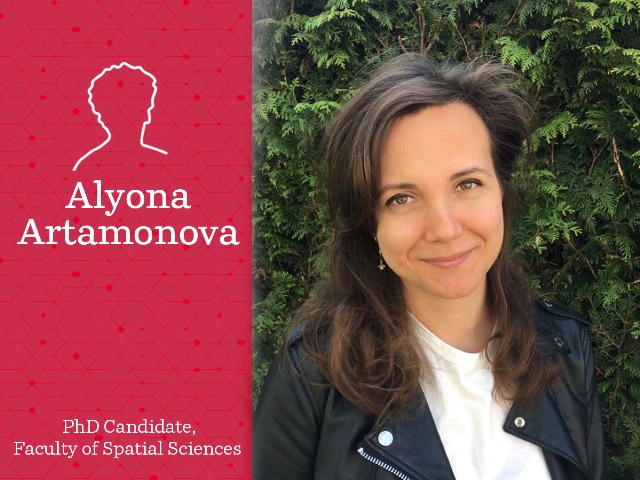ATN Blog - On characteristics of family members and usage of formal care services in older adulthood
| Datum: | 28 april 2022 |

Alyona Artamonova, PhD candidate at the Department of Demography, Faculty of Spatial Sciences (RUG). Her thesis is part of the Family Ties project; contact: a.artamonova@rug.nl
An important motive for having children in some Eastern European countries is “to have someone who brings a glass of water at the end of life”. This adage implies that adult children should remain nearby older parents in order to prevent them from relocating to institutionalized care facilities and/or dying surrounded by professionals rather than family members. This ‘last glass of water’ metaphor represents a family-based social compact that “tells” us about how the availability and reliability of formal care services as well as opinions on whether the state or family members should be responsible for the care of older adults shape family relationships in later life.
My PhD thesis addresses the question of how various needs-related life circumstances of older adults are associated with their own and their relatives’ migration and immobility. To answer this question, my co-authors and I draw on full population register data from Sweden and Norway, countries where parents rarely expect to receive extensive care and “a glass of water” from their adult children at the end of life. Instead, they tend to rely on public care services that are widely available in both countries. Although the usage of care services was only of secondary interest in the PhD thesis, in this blog, I will share our findings on the interplay between characteristics of family members—especially adult children—and usage of formal care services in older adulthood.
Family and institutionalization in Sweden
In a study based on Swedish data (Artamonova, Brandén, Gillespie, & Mulder, 2021), we examined whether adult children's gender, number, and geographic proximity were associated with older parents’ relocations into institutionalized care facilities. To start with, living with a partner, who is usually ranked higher than adult children as a source of assistance, was typically associated with lower propensities of institutionalization. As for children, the distance to the closest child was found to be a more important determinant of the likelihood of institutionalization than the gender of the closest child and the number of children. The probabilities of moving to institutionalized care are significantly lower when older parents live in the same household or the same neighborhood with adult children compared to when they live far from their children. The negative effect of having a non-resident child living nearby on the likelihood of becoming institutionalized is more pronounced for older women than men. We did not find a relationship between older adults’ institutionalization and the number of children or closest child's gender.
Family and usage of formal care services in Norway
In a study based on Norwegian data (Syse, Artamonova, Thomas, & Veenstra, 2022), we examined how children’s proximity as well as partner and child(ren)’s resources are associated with older persons’ uptake of long-term care services (LTC)—specifically, practical assistance, in-home nursing, or institutionalized care. Older adults who do not have partners and/or children are more likely to use LTC than those who have at least one of these core family members. Older persons with resourceful partners (i.e., employed, degree-level education, above median income, not using LTC) and resourceful children (i.e., degree-level education) are the least likely to transit into any type of LTC. It appears that the resourcefulness of partners matters more than the characteristics and proximity of adult children. Having a resourceful partner and no adult children is associated with considerably lower risks of transitioning into LTC than having a resourceful child living nearby but no partner. In the absence of a partner, having a resourceful child living nearby is associated with lower risks of transitioning into LTC than having a non- resourceful child nearby. We separately estimated the risk of institutionalization. The overall trends for institutionalization are very similar to those observed for any LTC uptake.
Selection or protection?
Despite concerns that the welfare state has “crowded out” the family from the sphere of care, family members seem to play an important role in older adults’ usage of care services even in Norway and Sweden. At least two mechanisms might explain our findings on the relationships between availability of family members plus family's resources and the uptake of formal care services among older adults. First, as several previous studies have shown, having a partner and/or children is associated with better health and longevity (Waite & Lehrer, 2003; Kravdal et al., 2012, Perelli-Harris et al., 2018) which is to some extent driven by selection, with unhealthy people known to be less likely to be partnered (Goldman, 1993; Wiik & Dommermuth, 2014) and having children (Syse et al., 2022). Second, found associations could be attributed to a protective mechanism reflecting the availability of social, emotional, economic, and instrumental support as well as better regulation of health-related behaviors among older adults with partners and children (Waite & Lehrer, 2003; Monden et al., 2003; Lindström, 2009; Grundy & Tomassini, 2010). Family members could also play an important role in promoting contact with doctors and ensuring better follow-up care (Smith et al., 2009). Future analyses should consider exploring these mechanisms. What stays clear is that due to population ageing and strained public resources, the role of family in the future provision of care is expected to become progressively important in the years to come in many countries. Inequalities between older adults with and without families as well as with and without resourceful family members should not be overlooked.
This blog was made possible by the Aletta Talents Network. If you would like to contribute a blog for the ATN, please contact Tom at t.a.lowe rug.nl.
Click here to join the Aletta Talents Network!
Two mentioned studies from Sweden and Norway:
Artamonova, A., Brandén, M., Gillespie, B. J., & Mulder, C. H. (2021). Adult children's gender, number and proximity and older parents’ moves to institutions: Evidence from Sweden. Ageing & Society, 1-31. doi:10.1017/S0144686X21000556.
Syse, A., Artamonova, A., Thomas, M., & Veenstra, M. (2022a). Do characteristics of family members influence older persons’ transition to long-term healthcare services?. BMC Health Services Research, 22(1), 1-13. doi:10.1186/s12913-022-07745-5.
Other references:
Goldman, N. (1993). Marriage selection and mortality patterns: Inferences and fallacies. Demography, 30(2), 189-208. doi:10.2307/2061837.
Grundy, E., & Tomassini, C. (2010). Marital history, health and mortality among older men and women in England and Wales. BMC Public Health, 10(1), 1-14. doi:10.1186/1471-2458-10-554.
Kravdal, Ø., Grundy, E., Lyngstad, T. H., & Wiik, K. A. (2012). Family life history and late mid‐life mortality in Norway. Population and Development Review, 38(2), 237-257. doi:10.1111/j.1728-4457.2012.00491.x.
Lindström, M. (2009). Marital status, social capital, material conditions and self-rated health: a population-based study. Health Policy, 93(2-3), 172-179. doi:10.1016/j.healthpol.2009.05.010.
Monden, C. W., Van Lenthe, F., De Graaf, N. D., & Kraaykamp, G. (2003). Partner's and own education: does who you live with matter for self-assessed health, smoking and excessive alcohol consumption?. Social Science & Medicine, 57(10), 1901-1912. doi:10.1016/s0277-9536(03)00055-8.
Perelli-Harris, B., Hoherz, S., Addo, F., Lappegård, T., Evans, A., Sassler, S., & Styrc, M. (2018). Do marriage and cohabitation provide benefits to health in mid-life? The role of childhood selection mechanisms and partnership characteristics across countries. Population Research and Policy Review, 37(5), 703-728. doi:10.1007/s11113-018-9467-3.
Smith, S. K., Dixon, A., Trevena, L., Nutbeam, D., & McCaffery, K. J. (2009). Exploring patient involvement in healthcare decision making across different education and functional health literacy groups. Social Science & Medicine, 69(12), 1805-1812. doi:10.1016/j.socscimed.2009.09.056.
Syse, A., Thomas, M., Dommermuth, L., & Hart, R. K. (2022). Does women’s health matter for fertility? Evidence from Norwegian administrative data. Population Studies, 1-22. doi:10.1080/00324728.2022.2041075.
Waite, L. J., & Lehrer, E. L. (2003). The benefits from marriage and religion in the United States: A comparative analysis. Population and Development Review, 29(2), 255-275. doi:10.1111/j.1728-4457.2003.00255.x.
Wiik, K. A., & Dommermuth, L. (2014). Who remains unpartnered by mid-life in Norway? Differentials by gender and education. Journal of Comparative Family Studies, 45(3), 405-424. doi:10.3138/jcfs.45.3.405.



